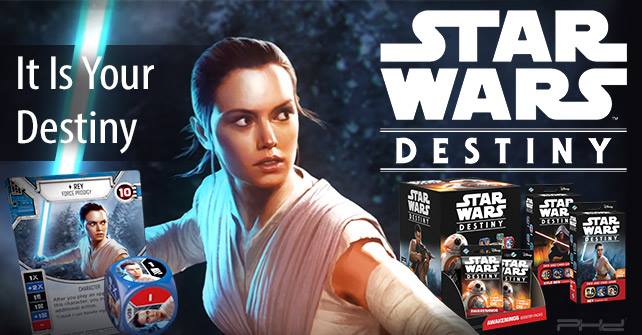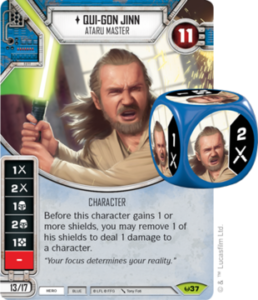
What is a CCDG? Well, it’s a new term coined by d20Radio: A Collectible Card and Dice Game, which is exactly what Fantasy Flight Games says it is. Star Wars Destiny is the newest offering in the line of Star Wars products that is one part Dicemasters and one part Magic: The Gathering with a dash of RNG that would make any strategic gamer crazy. I recently was able to take part in a pre-launch event at Common Grounds Games in Dallas, TX where I was able to field a team based on the starter set and six booster packs, but more on that later. At its heart, the game is a turn based card and dice game in which each player fields a team made up of characters, aligned as Hero or Villain, with a total value of 30 points. The sheer numbers of characters, even at this early stage of the game, adds enough variety for there to be hundreds of possible teams using the saga’s most well-known characters. Han Solo, Leia Organna, Rey, Fin, Poe Damron, Darth Vader, Count Dooku and General Grievous are just a few of those characters, and each one has a value assigned based on a number of factors. Each of these characters can be played with a single assigned die, or two dice, with increased cost. The starter sets feature Kylo Ren and a First Order Stormtrooper on the dark side and the light side features Rey and Fin, with BB-8 as a trust Droid support.
Each player takes a turn completing a single action, using his characters and cards in his 5-card hand. Players can discard a card to re-roll any or all dice, use resources to deploy new cards and reap the benefits of their effects, activate characters and roll dice, use support cards or play events that alter the course of the game. Dice rolled also have a variety of effects that can be resolved, from damaging an opponent to forcing them to lose cards or resources, or “special” effects that are unique to each character. Weapon upgrades, support cards and other cards also have the opportunity to add dice to a character’s roll so that they may do more damage or be more effective in their specific task.
The game is played similar to Magic or Dicemasters, in that typically the players are head to head, although card text is written to be open ended, suggested a 2v2 or larger format is coming soon. As each player takes actions, their hands are depleted, their dice are used and their events and abilities are tapped out. Once this happens, a secondary mechanic comes in to play, the claiming of the battlefield. Each player brings a battlefield to the game, each with a special effect when claimed. The player whose battlefield is selected starts the game, but either player can end their round and claim the battlefield to use the effect. It may be something like remove an opponent’s die or claim a resource, but the power, when used correctly can provide a difference in the game. The danger of course, is that once the battlefield is claimed, the turn is over for that player and his opponent can continue to perform actions until they cannot perform any more, creating a ptential for an unbalanced game.
By and large, I have experienced even games, although with a limited set of characters, the games are designed to be even. In my first game, I chose to use a single die Rey, a single die Fin and a Hired Gun. Pictured below is an example of a card for Qui-Gon Jinn.
 The character’s damage threshold is the number in the upper right, so Qui-Gon can take 11 points of damage before he is knocked out. As a player, you must decide if running two dice for 17 points is worth forgoing the opportunity to bring another character out with additional damage. The point value for each character is in the lower left, (13/17 for Qui-Gon). Special ability text is in the middle, and the examples of the die faces are on the left side.
The character’s damage threshold is the number in the upper right, so Qui-Gon can take 11 points of damage before he is knocked out. As a player, you must decide if running two dice for 17 points is worth forgoing the opportunity to bring another character out with additional damage. The point value for each character is in the lower left, (13/17 for Qui-Gon). Special ability text is in the middle, and the examples of the die faces are on the left side.
The game is remarkably easy to learn, yet very deep. I faced off with Rey, Fin and a Hired Gun against a new player who use Kylo Ren, a Stormtrooper and a single die Jabba The Hutt in his deck. During the game, Kylo and Rey each got light sabers for additional damage, Fin got his blaster, but after Rey died, he took the lightsaber and went to work. On the other side, Jabba did what Jabba does, he made my life miserable. His talents are all about creating a resource problem and making his opponent discard resources, so I barely had enough to get by and usually had to use my first action in a round after getting two fresh resources to deploy anything I wanted, because Jabba would simply make my dice and resources go poof during each round.
Fortunately, he is not a damage dealer, and the output from Ray and Fin with the hired gun proved too much, and once I got Kylo out of the way, it was down hill from there and I eventually won the game, for a sparkling record (so far). The victory condition is twofold: First, destroy the other players characters and win, easy as that. Second, cause a player to be out of cards and unable to draw cards during the refresh phase after both players pass and the game is over, with the cardless player forced to retreat in shame, taking the lonely walk of defeat.
More information can be found at FFGs site and the game is scheduled for release on December 1. Overall I am completely hooked on this game and look forward to bringing this game to Gamer Nation Con in March, 2017 where d20Radio will be holding a full Quartely event with FFG prize support. In the meantime, d20Radio’s own Knights of Ren podcast is a great place to start when it comes to learning the game, getting advice on which cards you will want to include and which to leave out as you begin building your competitive decks.
David Villegas - GM Dave
Latest posts by David Villegas - GM Dave (see all)
- Star Wars: Destiny CCDG Review - November 25, 2016
